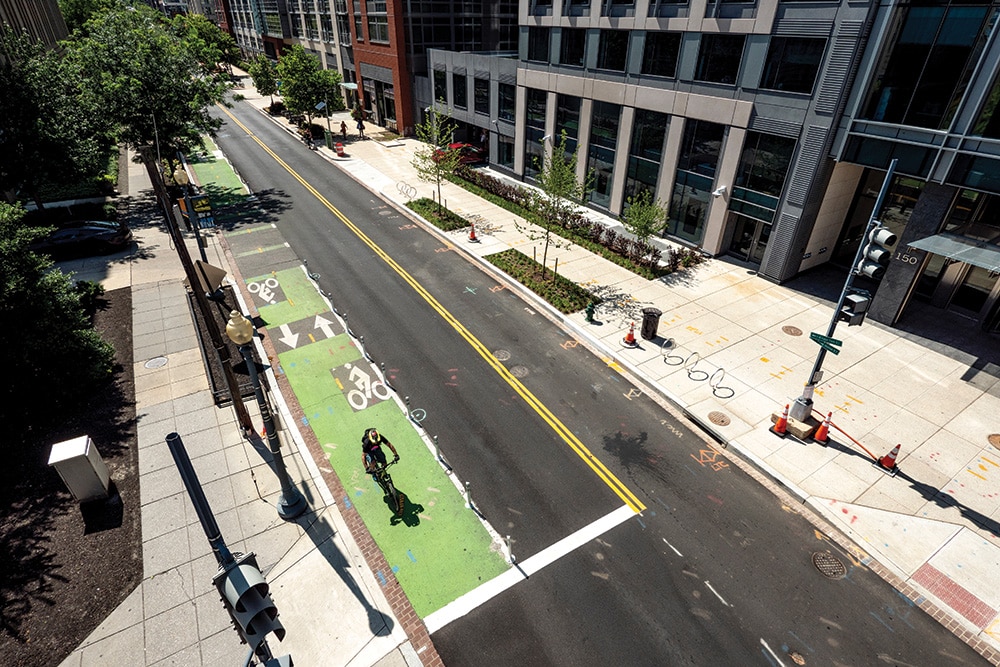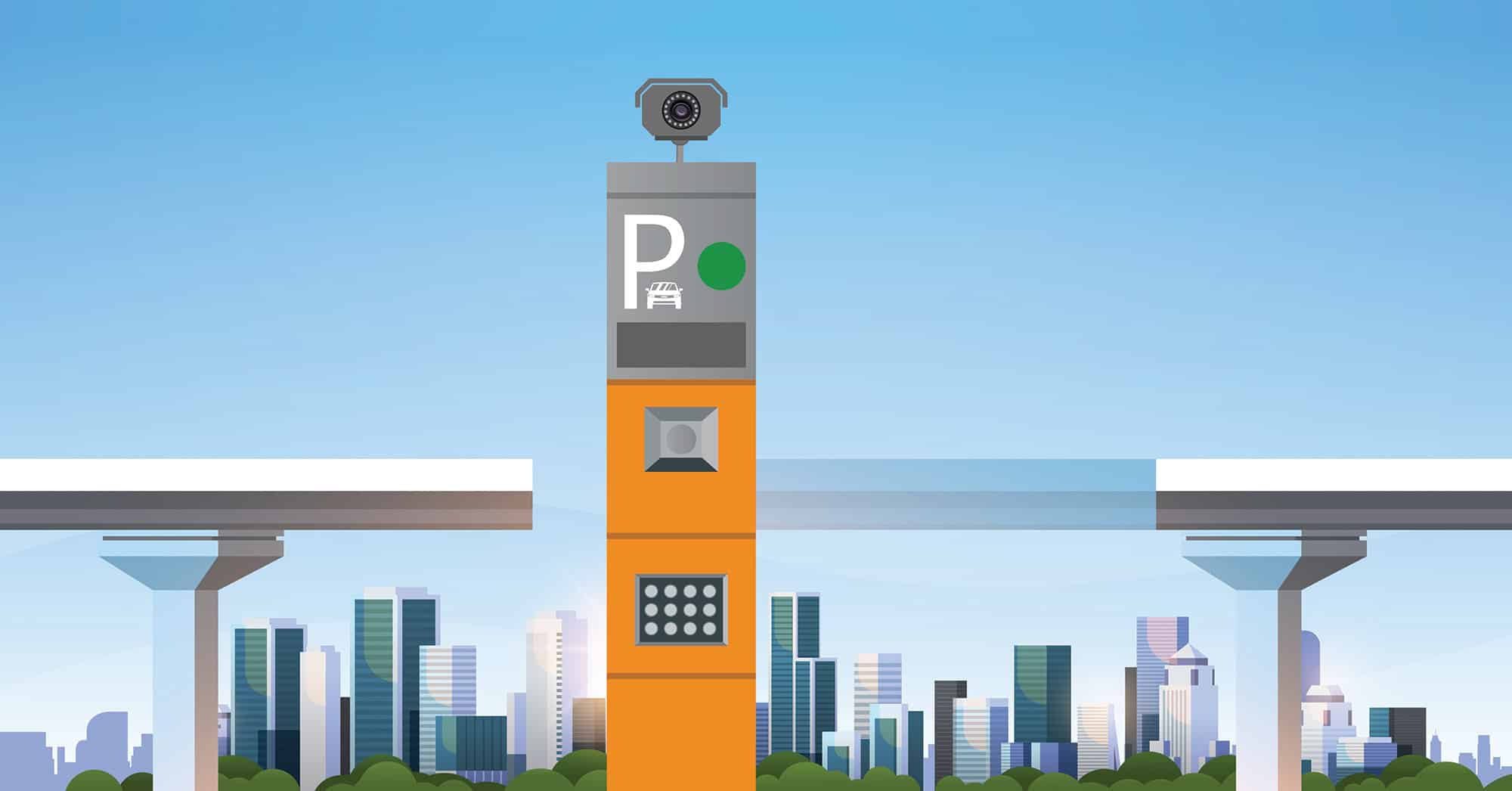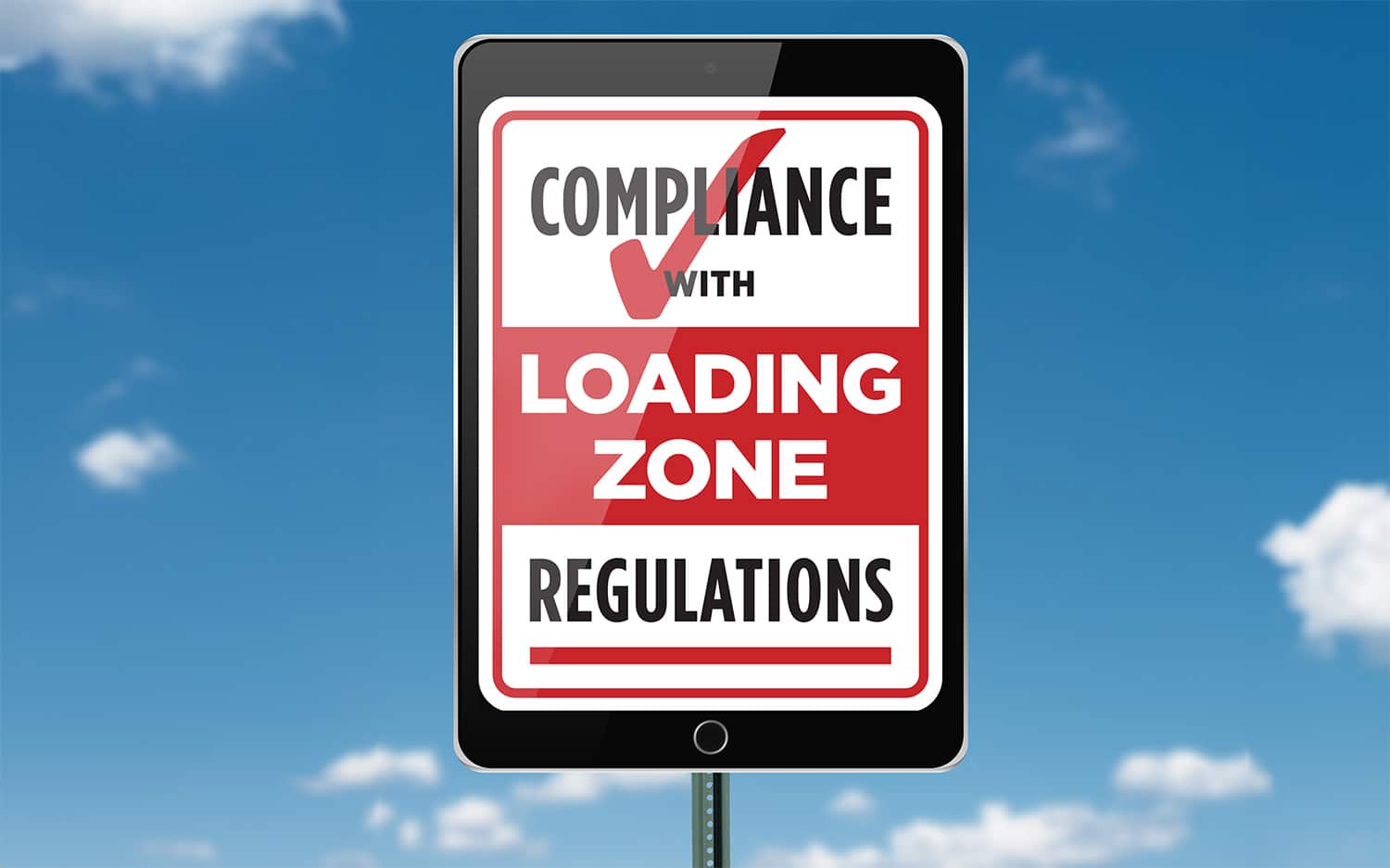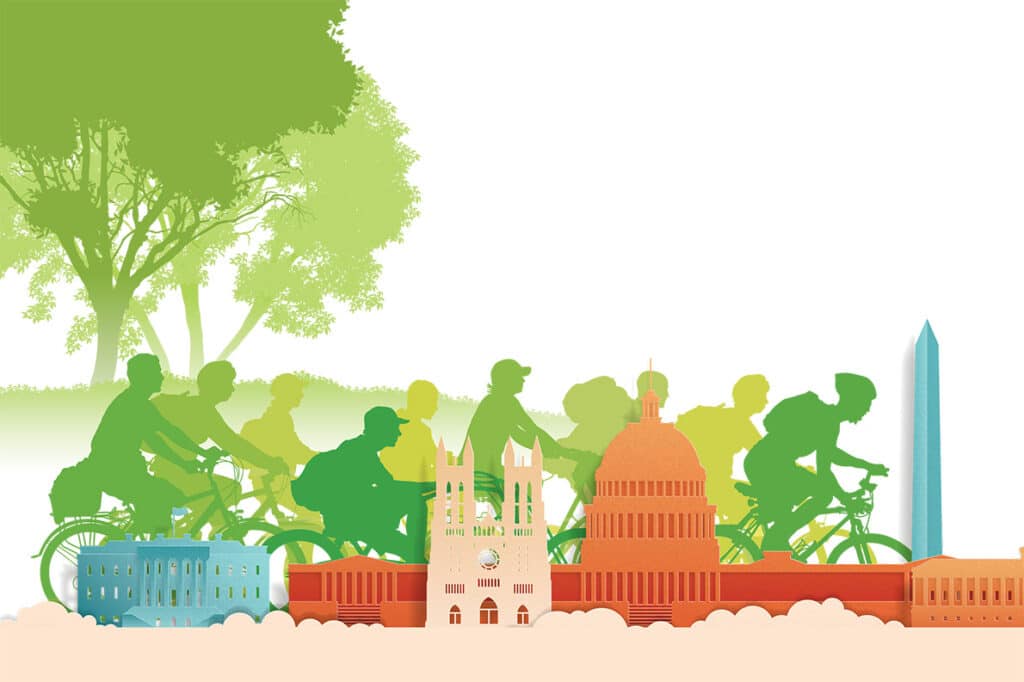
Flipping the Script
Sustainable Curbsides Communicate Our Values
THROUGH moveDC, the District of Columbia’s long-range transportation plan, District Department of Transportation (DDOT) elevates sustainability as a core goal to drive operations, project delivery, and internal business processes for the next few decades. The plan calls for a robust urban tree canopy, electrification of our transit fleet, and climate-resilient or “green” infrastructure. Most importantly, moveDC challenges all DDOT staff to think holistically about incorporating goals and policies into day-to-day work by explicitly recognizing that our goals are interrelated: a transportation network that provides safe, reliable multimodal transportation choices that also emphasize equity, reduce congestion, and cut down emissions.
Table of Contents
The integrative, multimodal, system-based thinking introduced in moveDC was already happening at the curbside. In 2021, the DDOT group formerly known as Parking and Ground Transportation changed its name to Curbside Management in recognition that vehicle storage is not always the highest and best use of public space. The interdisciplinary team in the Curbside Management Division not only manages the regulation of parking, but also ensures access for pedestrians, goods, transit vehicles, shared mobility, as well as people-focused spaces like parklets and streateries. Formally defined:
DDOT’s Curbside Management Division manages and regulates the District’s curbside. Our mission is to create safe and reliable access to the curbside for people and goods. We ensure that access is sustainable and equitable.
Sustainability is at the core of everything we do. Mayor Muriel Bowser demonstrates the District’s commitment to sustainability, not only through goals in moveDC but also through multi-agency efforts like Sustainable DC 2.0 and Clean Energy DC. For curbside management, sustainability’s added value is greater than the sum of its parts. Sustainable curbside programs and policies keep our most vulnerable residents safer, they promote economic opportunities, and make everything operate more efficiently. The most impactful tools the District currently uses to improve sustainability are safety for multimodal users, expanded use of pricing, and setting priorities by context.
Safety
For most of the 20th century, Washington, D.C. (like most U.S. cities) heavily invested in infrastructure that made private vehicle travel the fastest way to get around. Increased growth in the last two decades came with increased traffic and congestion in the District, while city leaders also recognized their role in cutting vehicle miles traveled to avert global climate change.
When DDOT became an independent agency in 2002, it focused on two key challenges related to sustainable transportation modes: pedestrian safety and mode shift. Pedestrian safety is critical, as all trips start with them. Pedestrians are the slowest moving, least protected, and least visible; they also accounted for 43% of DC traffic fatalities in 2021. To increase mode shift to sustainable modes, DDOT must make these modes safe, reliable, and efficient. Increasing reliability and travel speeds for transit, while focusing on safety for all modes, is critical to getting more people out of their cars for more trips, and that’s why Mayor Bowser has budgeted more than $317 million in fiscal year 2023 towards modernizing the District’s mobility.
Curbsides are the low-hanging fruit of pedestrian safety. To improve visibility for pedestrians in crosswalks, DDOT is daylighting more intersections by setting back parking at least 25 feet from the crosswalk. Other safety intersection treatments include using paint and flexposts to create inexpensive bulb-outs and starting an Art in the Right of Way program in slip lanes and near crosswalks. DDOT has also installed mid-block crosswalks and bulb-outs near schools and parks. These improvements shorten the distance for pedestrians to cross, force drivers to slow down at intersections, and increase visibility—especially of children or people using wheelchairs or other mobility devices that may not be in a driver’s line of sight if a parked vehicle is in the way. The safety improvements come at the expense of vehicle storage at each intersection, but they also visibly communicate the importance of protecting vulnerable roadway users.

The District is growing its bus and bike lane network ambitiously. Since 2020, DDOT has added more than 10 miles of red-painted bus lanes, 20 miles of protected bike lanes, and 20 queue jumps for buses. Each of these improvements requires planning, design, and community engagement to ensure the bus and bike lanes are reliable and safe. As any parking professional knows, the negotiation of parking and curbside impacts can make or break these projects. DDOT’s curbside planners meet at least weekly with engineers and planners to collaborate on design, prioritize and relocate impacted curbside uses, and communicate impacts and mitigations to stakeholders. Curbside planners and technicians have conducted hundreds of site visits and community meetings to understand the unique operations on a block or corridor and propose targeted solutions. Over the last few years, DDOT has improved offset bus lanes and bike lanes protected by curbs and a lane of parked cars, as well as tactics like signage placement and roadway hatching to improve compliance. While planners may think big picture, it’s Curbside Management’s job to solve for the errant vehicles that threaten the safety and compliance of bus and bike lanes. The better we do, the safer and more sustainable our transportation system becomes.
Pricing
Another way to frame the tradeoff between parking spaces and safety improvements is by ascribing value to each. At an agency level, DDOT does that through stating its goals in moveDC and implementing pedestrian and bicycle safety, as well as bus reliability strategies to meet these goals. But behavioral shift relies on similar decision-making and value tradeoffs by the millions of people who live in or travel to the District every year. The travel choices of these individuals will ultimately shape how sustainable our transportation system is, and the physical infrastructure can only go so far in terms of shaping behavior.
This is where curbside pricing is a critical level for sustainability, and in Washington, D.C., it is closely tied to equity. Like many cities, the District prices metered parking on its commercial blocks and has implemented several performance parking zones where prices fluctuate based on demand. These meters, however, are not just the traditional workhorses to induce turnover and recover costs of maintaining public infrastructure. They also signal the monetary value of public spaces, streateries, and other curbside uses; they help rational humans make tradeoffs.
At a policy level, DDOT relies on the D.C. Council, the District’s legislative body, to set pricing for meters, commercial vehicle loading, and permit parking in residential zones. The pricing policies are sensitive to long-term District residents who want to remain in the District and rely on affordable parking near their homes, accessibility for individuals with disabilities, and policies that can be applied equitably across a city of wealth extremes. However, these policies are universally communicating that our curbsides are a finite and valuable resource. Through charging for the use of an annual permit or 30 minutes of loading, the District demonstrates that curbside space is a public good and that private use comes at a cost (both monetary and opportunity).
Curbside and policy staff developed processes for school staff and contractors to purchase digital permits to park in residential zones. On the horizon is greater utilization of license plate reader technology and digital permitting to enable more targeted use of pricing based on demand. Our management of pricing is most notable in day-to-day operational decisions. Whether it’s enforcing full payment for private shuttles or mandating fees for short-term curbside reservations, DDOT staff work hard to keep curbside pricing consistent, fair, and essential to maintaining functional programming.
A key objective is to provide travelers with user-friendly tools and information that help them understand the value of their choices. The ultimate goal is that that travelers will become more intentional in their choices and all modes can be truly competitive options. For example, a doctor’s visit downtown may take more time by transit than driving but would be cheaper than parking in a garage; drivers also must factor in time spent searching for a legal on-street space, which may or may not be close to the destination. Similarly, a trip by taxi or rideshare may eliminate the need for parking but could cost more than parking. The District’s curbside pricing policies are moving in the right direction for sustainability, while also maintaining affordable options in residential areas and access for persons with disabilities.
Encouraging Sustainable Modes
The curbside policies and practices needed to enact a mode shift signal a mindset shift on the part of DDOT and its peer city transportation departments. We have flipped from the idea of curbsides as “private vehicle storage first” to “consider the context and expand our toolbox.” For example, traditional land use planners wouldn’t place a one-story, single-family home next to a high-rise office building. So why would we put a four-hour parking space in a high-traffic area during times of high transit and loading demand?
DDOT’s 2014 Curbside Management Study sets the foundation of curbside hierarchies based on neighborhood typology and establishes a menu of curbside uses (including metered parking). Since then, we’ve added curbside tools that work well in our evolving neighborhoods, such as programming for transient uses of the curb to support food and small goods delivery and passenger loading. In 2023, DDOT will update its toolkit and typologies to match city changes and consider new tools to meet its larger goals. Updated curbside typologies and tools are meant to help us communicate to residents the not-so-intuitive concept of a multimodal, context-sensitive curbside.
What do curbside typologies and context-based tools have to do with sustainability? By signaling that there are many possible uses for our curbsides—from vehicle-centric to green infrastructure—DDOT moves away from the expectation of curbsides as free public parking. We indicate that our public space can be used for mobility, access, safety, art, commerce, and play. In the next few years, we’re exploring new tools to add to the mix, like electric vehicle charging and automated enforcement to encourage turnover. There is no one-size-fits-all approach to curbside management, but we will consider and prioritize our goals when designing the curb. DDOT staff give voice to the goals of sustainability and its close relationship to equity and access in this process.
Additionally, the District has continued to expand and monitor its motorcoach parking program. Prior to the COVID-19 pandemic, the District saw as many as 1,200 charter/tour buses daily at the peak of summer tourism. In 2023, we expect numbers at or approaching pre-pandemic levels. DDOT manages permitting for dozens of shuttle, sightseeing, and commuter buses. These operators use curbsides in slightly different ways that often overlap and compete with other uses. Finally, DDOT collaborates with sister agencies to manage curbside uses around large entertainment venues and for groups participating in First Amendment activities to provide space for authorized vehicles and safely move pedestrians en masse.
The Curbside Management Division at DDOT continues to flip the script on the use of our curbs. The more we do to encourage shared and sustainable transportation modes, both at the curb and throughout our transportation system, the fewer emissions the transportation sector will produce. This makes our city safer for vulnerable users and better connects our residents and visitors to available opportunities. ◆
Haley Peckett is Associate Director, Curbside Management Division, for the District Department of Transportation.
-
This author does not have any more posts.


Bridging the Generation Gap
Technology s Transformative Role in Shaping the Parking Workforce

Compliance with Loading Zone Regulations
Using Technology to Reduce Chaos and Pollution





